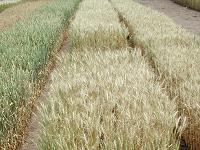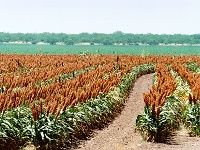

| February 1, 2005 |
 |
|---|
 I have been asked to develop 10 questions with answers for use on a Q & A site being developed at College Station. What questions are you being asked? I will include the top 10 each month in the agronomy newsletter.
I have been asked to develop 10 questions with answers for use on a Q & A site being developed at College Station. What questions are you being asked? I will include the top 10 each month in the agronomy newsletter.
The answers to the first 5 questions came from the USDA Grain Inspection Handbook (http://www.usda.gov/gipsa/reference-library/handbooks/grain-insp/grbook2/gihbk2.htm)
1) What is the test weight per bushel of wheat?
U.S. Number 1 Hard Red Winter Wheat has a minimum test weight of 60 pounds per bushel.
2) What is the test weight per bushel of rye?
U.S. Number 1 Rye has a minimum test weight of 56 pounds per bushel.
3) What is the test weight per bushel of oats?
U.S. Number 1 Oats has a minimum test weight of 36 pounds per bushel.
4) What is the test weight per bushel of barley?
U.S. Number 1 Barley has a minimum test weight of 47 pounds per bushel.
5) What is the test weight per bushel of triticale?
U.S. Number 1 Triticale has a minimum test weight of 48 pounds per bushel.
6) What are the concerns with late planted Hard Red Winter Wheat?
The major concerns that come to mind are:
With those six concerns in mind, producers may still decide to plant wheat late knowing that the yield potential would be low. It will cost about seven to nine bushels of grain to pay for the harvest cost and hauling. I'm not sure that most of late emerging acreage will produce more than 15 bushels on an average year.
7) When should a second application of nitrogen be made to wheat to be harvested as grain?
Only a small portion of the total nitrogen used by the crop is required prior to jointing (usually around 20 to 30%). Topdress nitrogen is best utilized if applied prior to jointing. Evaluate fields as growth begins in the spring. If tiller numbers are low, producers will want to apply the fertilizer early. The amount to apply should be based upon amount of nitrogen present in the field and yield potential. Ungrazed wheat will use about 1.7 pounds of nitrogen per bushel of yield. Base rates on projected yield considering: 1) the crop condition, 2) availability of moisture, 3) residual nitrogen at planting (from soil test), and 4) amount of fertilizer applied preplant. Source of nitrogen has little to do with yield response. Apply the source that can be most efficiently and economically applied. To reduce leaf burn with high rates of liquid applicator, consider using dribble nozzles.
By late February, the wheat will reach a stage of growth where nutrient and water uptake is increasing. If producers intend to get the most from the dollars invested in fertilizer, they need to apply nutrients just before winter dormancy ends. Soil nutrient levels need to be at a high level when the formation of the head occurs. If the head can be found above the soil surface the producer has lost the opportunity to impact the number of spikelets per head and the number of seeds per spikelet. The only other variable of production remaining that can be influenced by the nitrogen applied in the spring is seed size.
8) What should I do to control Wild oats that emerged late in wheat?
To improve the level of weed control producers are advised to: 1) check the weather forecast and make sure that night time temperatures will be above 40 degrees for two days prior and following the application, 2) have adequate soil moisture at the time of application, 3) read and follow the herbicide label, 4) apply at least 15 gallons of water per acre, and 5) apply herbicides to young unstressed weeds. For more information about Wild oats and its control please read this linked publication (http://sanangelo.tamu.edu/agronomy/wheat/wildoat.htm).
9) What are some of the cultural practices that can be used to reduce Hessian Fly populations?
Some of the best cultural practices that can be used to reduce the population of Hessian Fly are: 1) Don't spread the problem--be sure that harvesters are clean before they leave the field. 2) Turn the residue under (9 or more inches is needed). 3) Select resistant varieties to plant next season. 4) Plant late; for the area around San Angelo, planting before November 1 would allow for multiple generations of the Hessian Fly to develop. For more information go to http://ianrpubs.unl.edu/Insects/g46.htm. One more note, the heat of a controlled burn is not hot enough to kill the insect at or below the soil surface. Burning wheat stubble would only get rid of the organic matter--not the insect.
10) I have a lot of winter weeds growing in the wheat residue that is to be plant cotton this spring. I was hoping to avoid plowing so what herbicide(s) would you recommend?
The winter weeds are using valuable soil moisture that should be used by the cotton crop to be planted. If you still have about 60 days before planting you could use several different herbicides. You need to determine what kinds of weeds you have and make sure that they are listed on the herbicide label. The least expensive broadleaf control herbicide is 2,4-D and it will eliminate a wide range of weeds. If the maximum daytime air temperatures are cool then the Ester formulation should be used. If you are concerned about other weeds that may emerge prior to planting you may want to include a herbicide that is soil active for a short period of time. Special consideration should be given to the crop that is going to be planted; use only approved herbicides and rates. Tests were conducted in 2002 and 2003 on controlling winter weeds the link to the studies are (http://sanangelo.tamu.edu/agronomy/newsltr/weed02a.htm) and (http://sanangelo.tamu.edu/agronomy/newsltr/weed05.htm). The herbicides listed in the last table in each report is linked to a picture of that treatment in the test.
 On March 1, the Concho Valley Cotton Conference will be held at the San Angelo Convention Center. There are a number of specialists from across the state involved in this activity. This will be a training opportunity for agents with cotton responsibility. The training will be focused at mid-level experience. If you understand the significance of node to height ratio and what cutout is then you probably don't need this training. Please contact me if you're interested in attending. The presentations made at the production conference qualifies as training for agents with higher levels of cotton expertise (please contact Rick Minzenmayer if your interested in attending). The Conference will give all agents in cotton producing counties the opportunity of increasing their knowledge on plant growth and development. Linked is a copy of the agenda.
On March 1, the Concho Valley Cotton Conference will be held at the San Angelo Convention Center. There are a number of specialists from across the state involved in this activity. This will be a training opportunity for agents with cotton responsibility. The training will be focused at mid-level experience. If you understand the significance of node to height ratio and what cutout is then you probably don't need this training. Please contact me if you're interested in attending. The presentations made at the production conference qualifies as training for agents with higher levels of cotton expertise (please contact Rick Minzenmayer if your interested in attending). The Conference will give all agents in cotton producing counties the opportunity of increasing their knowledge on plant growth and development. Linked is a copy of the agenda.
As you know the way we design and conduct cotton variety tests have changed. I still attempt to include the varieties that the producer wants and varieties that perform well in the county. However, there are 26 new varieties being introduced to the market in 2005. Our main thrust is to eliminate varieties that don't perform before they make it into large scale production. To do this we have to put varieties into a wide range of tests. We are serving our producers well if we can identify what genetically superior lines are available and what their growth and development traits are. Contact me soon and let's design your 2005 Result Demonstrations.
Linked is the production data from cotton variety tests conducted in 2004. With the rainfall received in 2004 many producers had the best crop ever. Yields and fiber qualities were influenced by the year. They still show the genetic potential but how the varieties will perform in a hot, dry year is still to be determined.
El Paso County (2 tests), Fisher County (1 test), Glasscock County (13 tests), Howard County (3 tests), Midland County (1 test), Nolan County (1 test), Runnels County (3 tests), and Tom Green County (1 test).
Due to the wet fall in 2004 seed supplies of some varieties is limited. If you have a favorite cotton variety, you may want to book seed now. Some cottonseed retained for delinting has been tested and the free fatty acid contents is above 4. It is generally a recommendation not to keep cottonseed with a free fatty acid content above 1. Cottonseed with a free fatty acid content is losing vigor rapidly and getting a uniform stand will be very difficult. Also, cotton producers that like to plant in marginal soil temperatures should plant cottonseed with a cool-warm vigor index above 155. Two of the large seed companies are conducting the cool germination test and the warm germination test on every seed lot that they have. Producers can request a copy of that information and by combining the numbers obtained from both tests, determine the cool-warm vigor index for the seed lot. Only those seed lots with a high vigor index should be planted when cool soil temperatures exist at planting time.
The rains received during January may result in weed emergence in acreage where seedbeds have already been prepared. An application of 2,4-D will control a broad spectrum of broadleaf weeds, however, the replant window can be up to 90 days. Read and follow the herbicide label.
 It is time to request Corn, Grain Sorghum and Forage Sorghum seed for 2005 result demonstrations. If you need additional information about the varieties and hybrids available, I have compiled a list of company web sites and the URL is: http://sanangelo.tamu.edu/agronomy/newsltr/company.htm. Companies need to be contacted in the near future to acquire the seed you need for testing.
It is time to request Corn, Grain Sorghum and Forage Sorghum seed for 2005 result demonstrations. If you need additional information about the varieties and hybrids available, I have compiled a list of company web sites and the URL is: http://sanangelo.tamu.edu/agronomy/newsltr/company.htm. Companies need to be contacted in the near future to acquire the seed you need for testing.
There will be a meeting conducted February 8, 8:30 a.m. at the Cross Plains Community Center. The educational meeting will be worth 5 CEUs (1 IPM, 1 Laws/Reg, 3 General) for TDA license holders that complete the paperwork. For additional information contact Robert Pritz at (325) 854-1518.
February 9, Jones and Fisher Counties will be conducting a CEU Course. TDA license holders that attend can earn 5 CEU credits. Anyone planning to attend and/or needing additional information contact Todd Vineyard at (325) 823-2432 or Steve Estes at (325) 776-3259.
There will be a meeting conducted February 10, starting at 1:00 p.m. at the Texas A&M Agricultural Research and Extension Center north of San Angelo, Texas. The educational meeting will be worth 5 CEUs for TDA license holders that complete the program and paperwork. For additional information contact John Begnaud at (325) 659-6522. Linked is the agenda for the meetings.
On Monday, February 14, there will be a training conducted at Abilene for producers needing to obtain a Private Applicators License. For more details and to register for the meeting call Gary Bomar at (325) 672-6048.
There will be a meeting conducted during the Texas Farm & Ranch Expo (Abilene, Texas) on February 22 & 23, 2005. For TDA license holders, 10 hours of CEUs will be available on February 22 and February 23. For additional information contact Gary Bomar at (325) 672-6048. Linked is the agenda for the meetings.
 February 1 - 3, Travis County, Texas and Oklahoma Physiology Study Group Meeting
February 1 - 3, Travis County, Texas and Oklahoma Physiology Study Group Meeting
 February 7, District Office, Office Conference
February 7, District Office, Office Conference
 February 8, Callahan County, Forage Production Meeting
February 8, Callahan County, Forage Production Meeting
 February 9, Jones County, Multi-County Cotton Conference
February 9, Jones County, Multi-County Cotton Conference
 February 10, Tom Green County, CEU Course
February 10, Tom Green County, CEU Course
 February 17 - 19, Nashville, Tennessee, Southern Region Officers Training Meeting
February 17 - 19, Nashville, Tennessee, Southern Region Officers Training Meeting
 February 22 & 23, Taylor County, Texas Farm & Ranch Expo
February 22 & 23, Taylor County, Texas Farm & Ranch Expo
 March 1, Tom Green County, Concho Valley Cotton Conference
March 1, Tom Green County, Concho Valley Cotton Conference
 March 7, District Office, Office Conference
March 7, District Office, Office Conference
 March 22, Brown County, County Ag Day
March 22, Brown County, County Ag Day
 March 19, Tom Green County, Professional Ag Workers Meeting
March 19, Tom Green County, Professional Ag Workers Meeting
 March 29, Jones County, Multi-County Cotton Conference
March 29, Jones County, Multi-County Cotton Conference
 March 30, Nolan County, Multi-County Cotton Conference
March 30, Nolan County, Multi-County Cotton Conference
Sincerely,
|